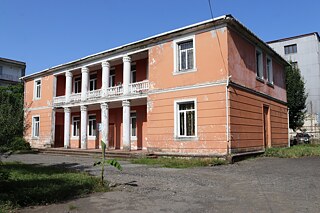Kobuleti
The physical mapping process for the municipality included both theoretical and practical aspects for two months. Experts, along with the educational component of the developed mapping methodology, mentored the municipality’s working group through each step of the process.
A detailed list of buildings and spaces was created. To collect information about these objects, research was conducted through inter-sectoral cooperation, fieldwork, and photofilming. The gathered data was then analyzed and recorded on a digital map, and the results were presented.
A detailed list of buildings and spaces was created. To collect information about these objects, research was conducted through inter-sectoral cooperation, fieldwork, and photofilming. The gathered data was then analyzed and recorded on a digital map, and the results were presented.
Physical Mapping Results
In the municipality of Kobuleti, of the 31 mapped properties, 32% are cultural and creative spaces, 19% are administrative facilities, and 13% are educational institutions. Industrial or production facilities, as well as trade infrastructure and other types of buildings, each account for 10%. Additionally, sports and transportation infrastructure make up 3% each.
The usage of listed properties follows as 32% in active use, 36% partially utilized, and 32% nonfunctional.
The structural condition of the mapped buildings is that 12% have been rehabilitated, 43% exhibit minor damage, 29% are severely damaged, and 11% are structurally stable.
In Kobuleti, 58% of the listed properties are municipally owned, 12% are privately owned, 26% are state-owned, and 4% are mixed ownership. The majority of these properties are registered.
Among the important properties are: The post office building, The Kvirikes club, and administrative building, The old bread factory, Lao Jinjiang’s house in Chakvi, The Daghvas Cultural House, The Kakuti Cultural House, The Khalas Cultural House, The Alambri Cultural House and administrative building, The Laghvas Cultural House and administrative building, The Bobokhvati Cultural House.
The usage of listed properties follows as 32% in active use, 36% partially utilized, and 32% nonfunctional.
The structural condition of the mapped buildings is that 12% have been rehabilitated, 43% exhibit minor damage, 29% are severely damaged, and 11% are structurally stable.
In Kobuleti, 58% of the listed properties are municipally owned, 12% are privately owned, 26% are state-owned, and 4% are mixed ownership. The majority of these properties are registered.
Among the important properties are: The post office building, The Kvirikes club, and administrative building, The old bread factory, Lao Jinjiang’s house in Chakvi, The Daghvas Cultural House, The Kakuti Cultural House, The Khalas Cultural House, The Alambri Cultural House and administrative building, The Laghvas Cultural House and administrative building, The Bobokhvati Cultural House.






